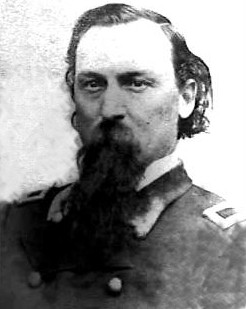George D. Wagner facts for kids
Quick facts for kids
George Day Wagner
|
|
|---|---|

George D. Wagner
|
|
| Born | September 22, 1829 Ross County, Ohio |
| Died | February 13, 1869 (aged 39) Indianapolis, Indiana |
| Place of burial |
Armstrong Cemetery, Green Hill, Indiana
|
| Allegiance | United States of America | Union |
| Service/ |
United States Army Union Army |
| Years of service | 1861-1865 |
| Rank | |
| Battles/wars | |
George Day Wagner (born September 22, 1829 – died February 13, 1869) was an important person from Indiana. He was a farmer, a politician, and a soldier. He served as a general in the Union Army during the American Civil War. While he did well in many battles, his actions at the Battle of Franklin in 1864 caused some debate.
Contents
Early Life
George Wagner was born in a country area of Ross County, Ohio. When he was four years old, his family moved to Warren County, Indiana. There, he went to local schools. He grew up to be a successful farmer.
In 1856, he was chosen to be a Republican representative in the Indiana House of Representatives. Two years later, he was elected to the State Senate. He also became the president of the Indiana State Agricultural Society. He held this job when the Civil War started in April 1861.
A Soldier in the Civil War
In June 1861, Wagner joined the army as a colonel. A colonel is a high-ranking officer. He led the 15th Indiana Infantry in western Virginia.
Early Battles
In April 1862, he led the 21st brigade at the Battle of Shiloh. A brigade is a large group of soldiers. He also fought in the Battle of Perryville. Later that year, he led the 21st brigade again at the Battle of Stones River.
In April 1863, he was promoted to brigadier general. This is a very high rank in the army. He led the 21st brigade during the Chattanooga Campaign in September 1863. His soldiers stayed in Chattanooga, Tennessee to protect the city during the Battle of Chickamauga. His men fought bravely at Missionary Ridge.
The Atlanta Campaign
In 1864, General Wagner was part of the Atlanta Campaign. He led the 2nd brigade in the IV Corps. His troops faced very tough fighting at the Battle of Kennesaw Mountain. Later, he led a larger group of soldiers called a division during the Franklin-Nashville Campaign.
The Battle of Franklin
General Wagner's military career changed a lot at the Battle of Franklin. He was told by his leader, Brig. Gen. Jacob D. Cox, to pull his soldiers back. His troops were in a dangerous spot and were outnumbered.
However, Wagner decided to stay and fight. When the Confederate soldiers attacked, two of his brigades were pushed back. They ran towards the main Union defense line, mixed in with the attacking enemy. This made it hard for the main Union army to shoot, because they didn't want to hit their own soldiers.
Because of this, the Confederate soldiers were able to break through the Union lines. Other Union soldiers quickly came to help and fixed the problem. But General Wagner's decision was questioned a lot. After this battle, Wagner asked to leave his command. He said it was because his wife was sick. He was sent back to Indiana. He served briefly in St. Louis, Missouri, near the end of the war. He left the army in August 1865.
After the War
Less than a year after the war, General Wagner's wife passed away. In 1866, he started working as a lawyer in Williamsport, Indiana. He became president of the state Agricultural Society again. He helped teach people about new farming methods.
George Wagner died suddenly in Indianapolis, Indiana. He was buried at Armstrong Cemetery in Green Hill, Indiana. This was close to the farm where he grew up.
See also
- List of American Civil War generals (Union)
- List of Ohio's American Civil War generals
- Ohio in the American Civil War

